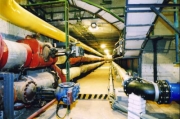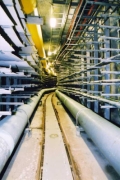"Prague is the only capital city that has nearly completed a comprehensive network of tunnels which serve the most important parts of the city. The overall length is 90 kilometers. Compare it to Berlin - it has 25 kilometers, Paris has around 20 kilometers. It is not a problem to add any new wires or pipes - the system has been built to last for 200 years and to contain networks which don't yet exist today. Also, even before 2001 we implemented excellent security systems - of course, I'm not going to disclose any details. We have practically excluded the possibility of anyone getting into these systems. With gas pipes and so on, they could be potentially very vulnerable. It was an idea that no one else had had."
Visitors to the underground tunnels are equipped with overcoats and hard hats and a tour guide shows them round some of the most interesting parts. I asked Otakar Capek which utilities can be found there.
 "Everything from gas pipes, steam pipes, water mains, to pneumatic postal service, high and low voltage cables, data cables, telecommunications cables and also special networks connecting individual companies. We have even been asked to install pipes to draw beer from restaurants."
"Everything from gas pipes, steam pipes, water mains, to pneumatic postal service, high and low voltage cables, data cables, telecommunications cables and also special networks connecting individual companies. We have even been asked to install pipes to draw beer from restaurants."
Otakar Capek says the utility tunnels or "kolektory" as they are called in Czech are a living organism which evolves constantly. In the deepest corridors, some 30-40 meters underground, a special train runs on five-kilometer routes transporting pipes, metal parts and other components. The tunnel is never complete; it is a never-ending process, says Otakar Capek and adds that this system, which he is so proud of, was mostly built during a historical period that tends to be looked down upon - the socialist era.
"Even in those days when there was a group of people who believed in something, who thought they were working on something meaningful, they could make it happen. The construction indeed had flaws of the socialist era. For example, after 1989 we had to renovate everything that did not meet safety standards. Such as fire doors made of cardboard, weak ventilators and so on."
 The Prague utility tunnels are looking forward to welcoming more tourists thanks to this new coordinated project, which is opening Prague's technological heritage to the public. And director Otakar Capek says there is more to see than wires and vaults.
The Prague utility tunnels are looking forward to welcoming more tourists thanks to this new coordinated project, which is opening Prague's technological heritage to the public. And director Otakar Capek says there is more to see than wires and vaults.
"Prague is a tectonically stable area but the geology is very complex. You can find gravel sands here, clay, slate, etc., and all that poses many problems. When we were digging the big tunnel between the Municipal House and the bottom of Wenceslas Square, we basically followed the route of a 13th century ditch. It was full of objects discarded there and remnants of the old city walls which were later demolished. We worked with archaeologists and many of the objects that we found are on display right there in the tunnel."
Individual companies in Prague are now joining the venture which hopes to boost incoming tourism in the capital. When can visitors see the newly opened technological monuments? Jan Hauser of the Prague Chamber of Commerce.
"This would obviously be a question for the owners and the people who are running these sites but we hope that this summer, meaning the summer of 2007, should be the time when the first doors are opened."




No comments:
Post a Comment